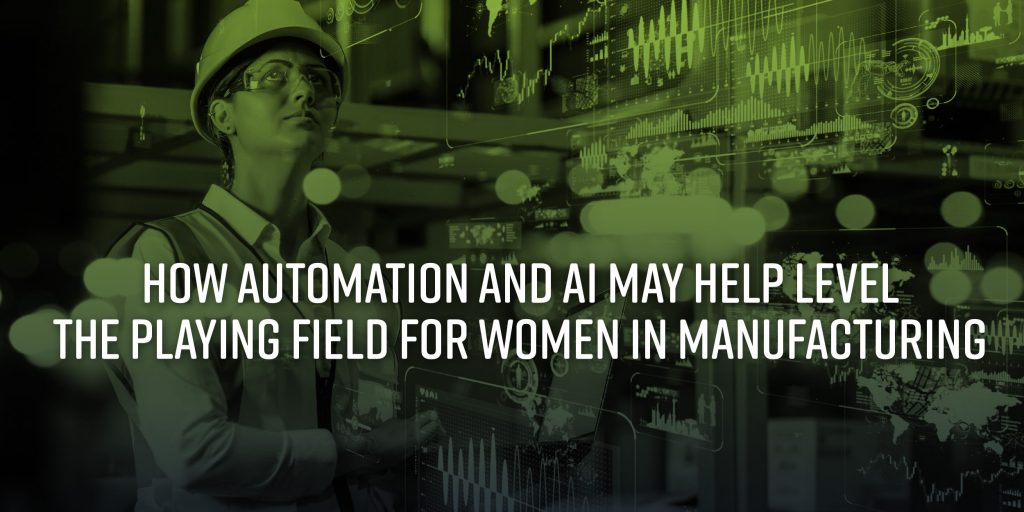Women make up about 29 percent of the manufacturing workforce despite filling 47 percent of the positions in the overall workforce, according to the Manufacturing Institute. While there have been periods of growth and decline, the dynamic is mostly unchanged since 1970, when women held 27 percent of the manufacturing jobs.
But many experts say the growing adoption of automation and artificial intelligence (AI), combined with the critical need for knowledge-based workers, will create more opportunities for women in manufacturing.
What Does Automaton, AI Look Like in the Manufacturing World?
The World Economic Forum in 2018 predicted that 75 million jobs would be displaced by technology by 2023, but 133 million would be created, many of which would be enhanced by technology.
Manufacturing has been at the center of automation as robots now perform once-manual tasks and make decisions based on real-time data, and it will continue to be so for AI. The robot density rate in the United States has increased to 189 robots per 10,000 workers; a rate that will only increase with higher adoption of automation.
Artificial intelligence algorithms designed to mimic human decisions already are being used via automation and Enterprise Resource Planning software to:
- Reduce downtime
- Increase productivity
- Determine the best materials and processes to design and manufacture parts
- Influence a facility’s production schedules and workflow
The Changing Nature of Manufacturing Will Attract Women
Manufacturing advances in automation and AI are shifting many jobs on the production floor away from task-based physical work. A worker once operating a single machine might now oversee several machines in a production pod.
Job roles and responsibilities are being rewritten to what many technology-minded young people prefer, brain power over brawn. The emphasis on software also puts everyone on a more level footing for training and advancement than the traditional tribal transfer of job knowledge. Newcomers to manufacturing often can see themselves growing with the evolving advanced manufacturing technology mindset.
Meanwhile, research shows that gender diversity benefits a manufacturing firm by improving its ability to innovate and providing higher return on equity and increased margins. Perhaps most importantly, more than half of women (58 percent) responded in a survey of manufacturers that over the past five years they have observed positive changes in their industry’s attitude toward female employees.
Hurdles Remain, from Culture to Employee Pipelines
While there is reason for optimism that women in manufacturing can help reduce the growing skills gap, legacy issues remain in the industry culture even when not intentional on an employer’s part, including gender gaps in pay and promotion, job retention and unconscious biases, such as how women’s digital skills are sometimes valued less than men.
While AI has expanded the number of STEM fields that can feed manufacturing, those preferred pipelines also have imbalances, including:
- Women hold about 24 percent of the jobs in the computer science workforce.
- A World Economic Forum study showed that women hold about 22 percent of AI jobs.
- About 20 percent of engineering graduates are female, which has remained relatively static for the past 10 years.
Intangibles That Could Contribute to Women Migrating to Manufacturing
As the largest underutilized pool of available workers to manufacturers, women can be the key to closing the skills gap.
Other considerations that could lead to more women in manufacturing jobs include:
- Patterns of job losses to AI are predicted to impact women more than men (52 percent of jobs vs. 40 percent.
- Healthcare will be a top category of added AI jobs in manufacturing, and it is a female dominated workforce.
- Reliance on higher education favors women, who outnumber men in enrollment.
Opening Doors
Women earn more than half of all associate’s, bachelor’s and master’s degrees and make up more than half of U.S. based professional and managerial positions. There is no question there are qualified women in the workforce.
Professional development groups for women in STEM fields and manufacturing are experiencing massive growth. Companies that adapt to the rise in automation and AI by reskilling their workforce and instituting a better work culture will open doors for women across many industries.
Do you need help with workforce development? Connect with the experts at your local MEP Center to learn how they can help you strengthen your workforce.
This blog was written by Nicole Ausherman and is curated from the NIST Manufacturing Innovation Blog. You can read the original article here.

